Biodiversity Conservation
At every phase of its business activities, including R&D, design, construction, and maintenance, Obayashi remains committed to technological development that preserves and creates ecosystems with rich diversity, while endeavoring to avoid or mitigate environmental impact at construction sites and surrounding areas.
Conserving Ecosystems
Prior to the start of construction work, the sales division prepares an environmental risk check sheet and shares information with the stakeholders at meetings, such as kick-off meetings, about the ecosystem that must be conserved. At the planned construction site, we conduct preliminary surveys as necessary to confirm the growth and habitat conditions of the target species for conservation.
We formulate a conservation plan that includes the preparation of alternative habitats and the transplantation and relocation of target species for conservation. We then formulate a construction plan based on the conservation plan and implement reliable conservation measures. During and after construction, we conduct monitoring surveys of the growth and habitat conditions of the target species for conservation and implement further environmental improvements as necessary.

Examples of Initiatives for Ecosystem Conservation
Conserving ecosystems through biotope development and Maintanance
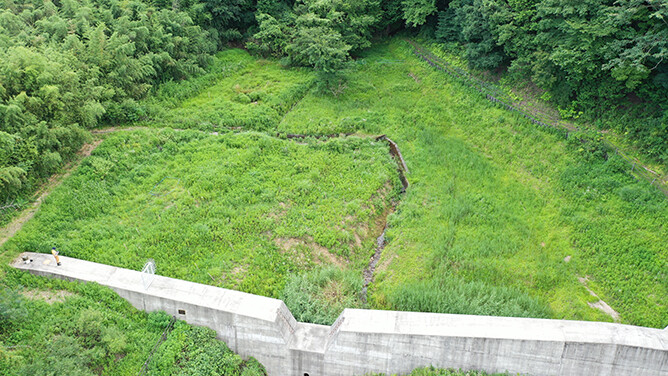

Yamanashi Prefecture's central final disposal site for residential waste (Kainokuni Ecopark) was constructed by an Obayashi joint venture company (*1). When the facility was under construction in 2018, we created two biotopes (*2) with the aim of preserving living organisms and the natural environment. The Joint venture company, including our company, is undertaking maintenance and management for 20 years after the completion of construction. We have been conducting ongoing maintenance and biota surveys for fireflies, dragonflies, frogs, and other species that have been confirmed as inhabiting the area around the project site.
When constructing the biotope, we made the most of the project site's topography and surrounding vegetation and arranged ponds, small streams, wetlands, and grassland to provide diverse habitats for organisms. The survey results confirmed the presence of the targeted organisms for conservation each year. They also confirmed that the creation and regular maintenance of the two biotopes, with their different environmental conditions, helped maintain and improve biodiversity in the vicinity of the project site. We will continue to strive to preserve biological and natural environments that are affected by construction projects.
- *1 Obayashi/Kubota Environmental Engineering/Yuzawa Kogyo/Naito Construction Joint Venture Company
- *2 Biotope is a term coined from the Greek words bios (life) and topos (place), and refers to a space where organisms (animals and plants) live
Conservation of rare birds of prey such as Hodgson's hawk eagle
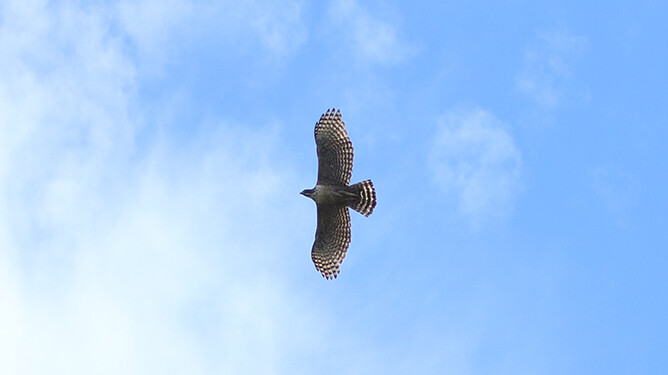
Since the planned site for Obayashi Group's Otsuki Biomass Power Plant is located near a nesting ground for Hodgson's hawk eagles, which are listed as endangered species on the Ministry of the Environment's Red List, we avoided large-scale construction work during the incubation period (February to June), when the Hodgson's hawk eagles' sensitivity is at its highest, and reduced the intensive operation of construction equipment and noise levels in consideration of the breeding period.
In the monitoring survey during construction, we did not observe any abnormal behavior of Hodgson's hawk eagles, such as watching the construction area and emitting alarm calls, due to noise and other impacts of the construction work. We also conducted monitoring for three years since 2018, when the power plant was put into service, and confirmed that Hodgson's hawk eagles have successfully bred for three consecutive years.
Conservation of the endangered golden orchid and thicket
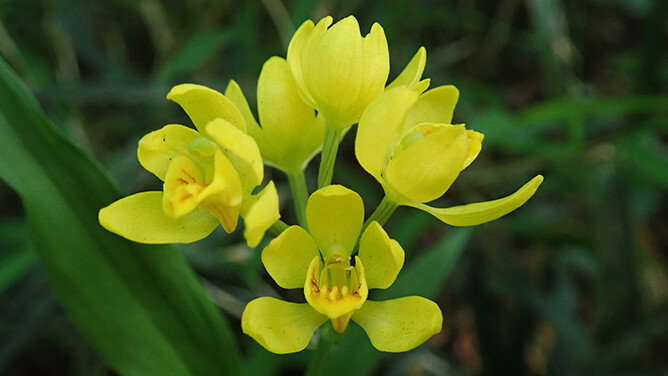
Since 1998, Obayashi Corporation has been monitoring the population, distribution, and growth of the golden orchid at its own Technical Research Institute in order to conserve the thicket and the golden orchid which is designated Class Ⅱ endangered species in Japan. Keeping the forest floor light and airy by moderately mowing the bamboo grass and vines and removing fallen branches and trees will maintain a suitable environment not only for the thicket but also for the fungi that nourish it. After 24 years of continuous management, the golden orchid population has increased from 233 to 727 individuals.
Rokka no Mori regeneration project
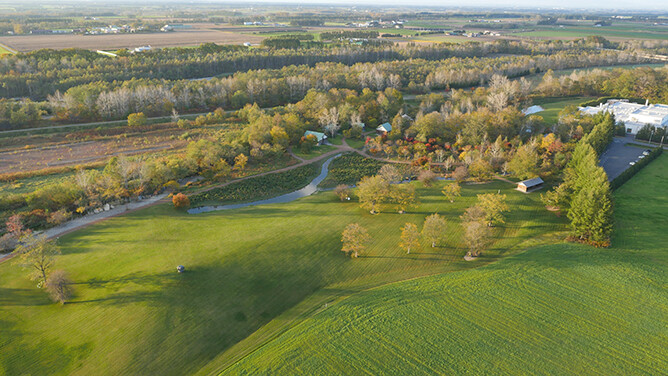
In the project to build a confectionery factory for Rokkatei Co., Ltd. near Obihiro City, Hokkaido, a site survey began in 1997, and over a period of 10 years, a vast area of approximately 10 hectares of land was regenerated as "Rokka no Mori" to create a factory in harmony with the rich natural environment surrounding the planned site.
The former river site was rehabilitated to build a stream and a pond, and a green corridor was created around the waterside with aquatic plants and flowers. The waterside is now alive with plants that attract small animals.
Survey on the impact of the installation of an offshore wind power understructure on fish in peripheral marine areas
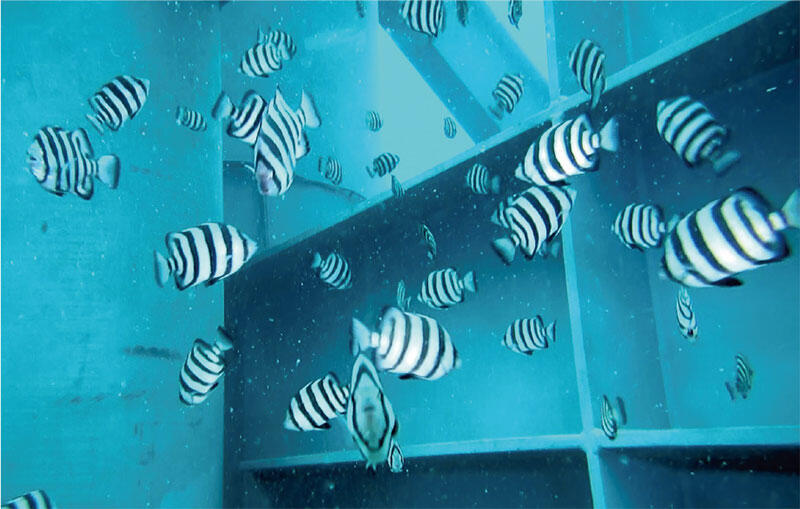
In the vicinity where a Skirt Suction®(*3) offshore wind power understructure was installed as a field test, Obayashi Corporation surveyed fish resources using a selfdeveloped underwater inspection robot dubbed DIAG®(*4), and environmental DNA(*5). As a result of the surveys, it was confirmed that the understructure played the role of a fish haven where coastal fish species such as parrot bass, red sea bream and Okhotsk Atka mackerel gathered.
Collaboration between offshore wind power generation and fishery is an important theme. We will continue to survey the maritime environment and contribute to preserving oceans and marine resources.
- *3 Skirt Suction
This is a self-developed technology in which the pile-supported understructure of the wind turbine penetrates the seabed with the help of hydraulic pressure. This makes it possible to fix understructures firmly in shallow seas where hard-to-penetrate bedrock emerges, a process difficult under conventional methods such as a monopile structure in which a single pile is driven down - *4 DIAG
A self-developed, unmanned submersible probe capable of the underwater inspection of dams, harbor structures, etc. with remote control from above water - *5 environmental DNA
DNA released from living organisms' body fluid, feces, etc. into water, soil, air, and other environments
Maintenance of forests held
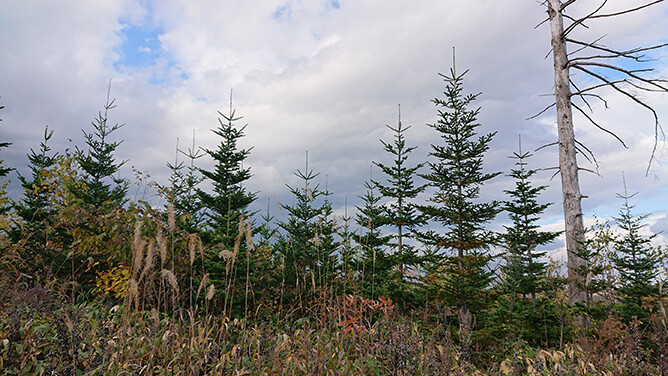
The Obayashi Group maintains approximately 450 hectares of forest under the approval of the Forestry Agency. A healthy forest ecosystem is maintained by "weeding," the removal of weeds, etc. under trees; "thinning," the removal of trees at appropriate intervals; and "improvement cutting," the removal of unnecessary trees for young forest.
Creating Biodiversity
In addition to conserving ecosystems, Obayashi Corporation is also working to create biodiversity through ecosystem assessment technologies.
Key Ecosystem Assessment Technologies
Ikimono-Navi®
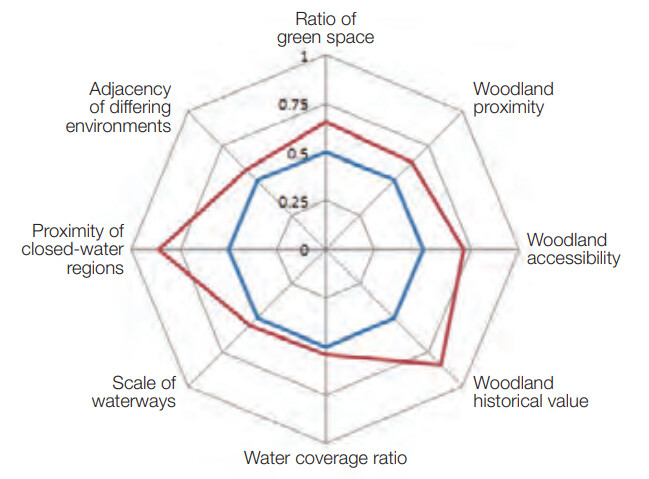
This is a bio-attractive environment assessment system designed to improve the quality of natural environment by securing or restoring biodiversity in planned development or construction sites.
The system evaluates the potential biological environmental characteristics of the target site based on the natural environmental characteristics of the planned site and the biological information database. Based on the results, we can identify creatures that can be brought to the planned site and show how to attract them.
Habitat evaluation model for living organisms
This technology can predict and visualize the locations that living organisms prefer to visit and the routes they take in urban green spaces. It is based on detailed surveys of the actual environmental conditions under which birds, dragonflies, and butterflies stayed and the roots they took, by region and season. Using the habitat assessment model before designing a green space allows to create an environment that is more likely to support living organisms.
Examples of Initiatives to Create Biodiversity
Urban rooftop greening (Namba Parks)
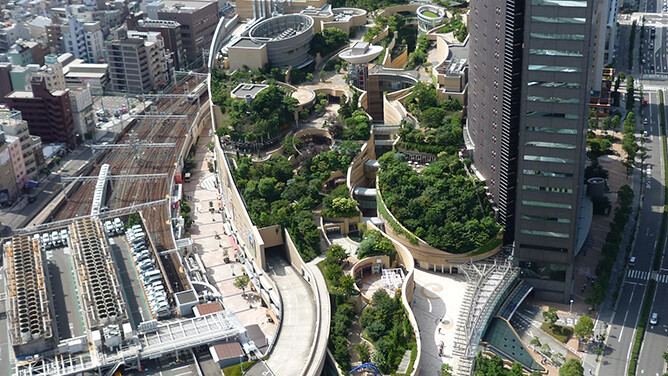
In an area of almost half of the 11,500 m² rooftop garden of the "Namba Parks" redevelopment complex in Osaka City, we created a rich living environment with about 100,000 trees and plants of about 500 species, 34 species of birds and 152 species of insects, creating a place where humans and living creatures can coexist within the city.
In addition, to confirm the effects of greenery on the urban environment, we have been investigating thermal environment evaluation using thermography, summer microclimate (cooling by trees), energy conservation, and CO2 fixation.
Urban rooftop greening (oak omotesando)
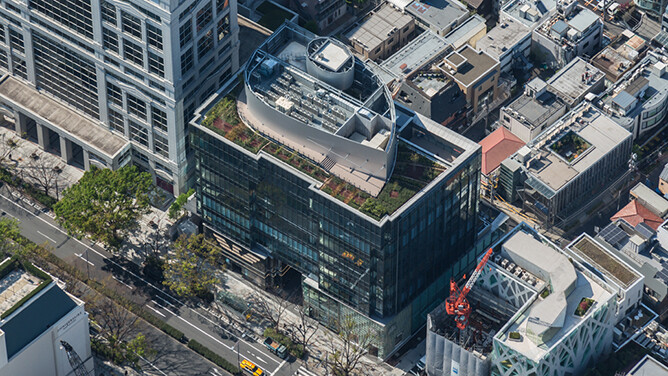
Utilizing the "Habitat Evaluation Model for Living Organisms" developed by Obayashi Corporation, elements favored by birds were arranged to provide a resting place for birds migrating through cities. This is the first solo rooftop greening project to receive JHEP certification (*6).
- *6 The only certification system in Japan that enables objective and quantitative evaluation, certification, and visualization of the contribution to biodiversity conservation, implemented by the Ecosystem Conservation Society-Japan
Survey of birds
In recent years, urban redevelopment projects have tended to include the development of green spaces. Obayashi conducted surveys of birds in various green spaces and city streets, including the Akasaka Intercity AIR and Shinagawa Intercity properties that we constructed, to verify whether the development of green spaces is improving urban biodiversity. The survey showed that birds, such as Japanese white-eye and Japanese titmouse, appeared much more frequently in urban areas with developed green spaces than in urban areas with only roadside trees.
This suggests that this type of greening is improving urban biodiversity to a certain extent.
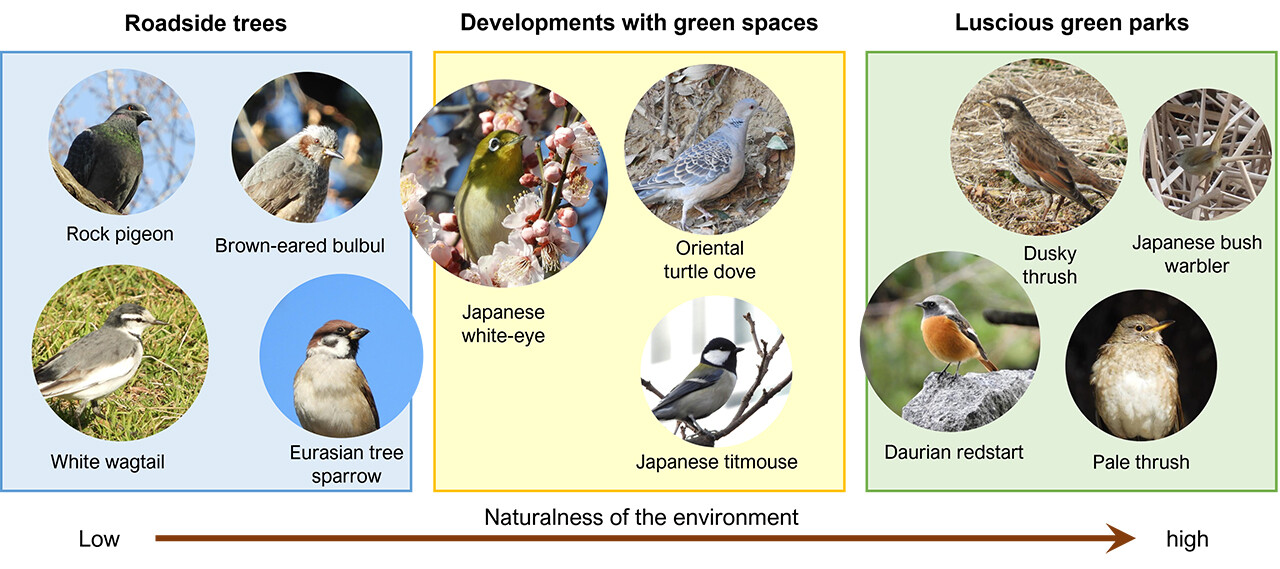
Greening experiments using grassland plants
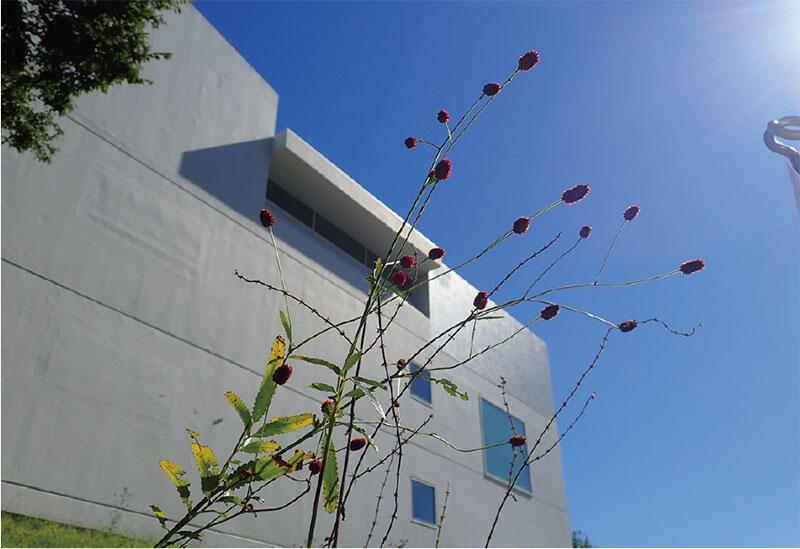
Our Technology Research Institute is conducting greening experiments using grassland plants in the Musashino region to clarify construction and management practice supporting grassland plants, which are rapidly decreasing in Japan.
We have also commissioned Biome Inc. to conduct a plant distribution survey in which citizens participate using an app for the collection of living organisms that enables their identification through a name-identifying AI function.

